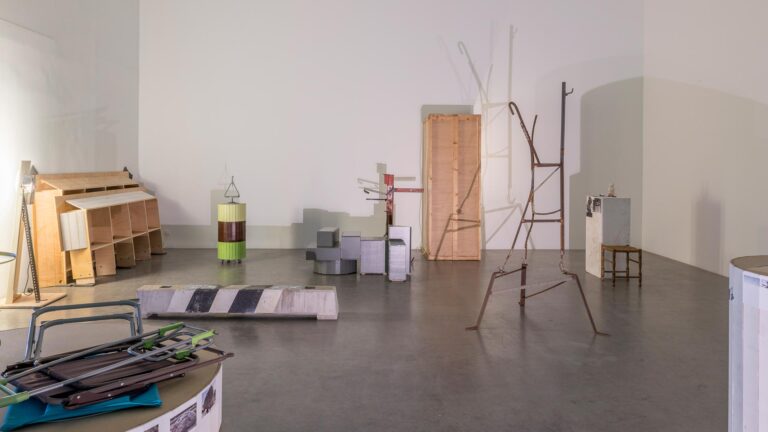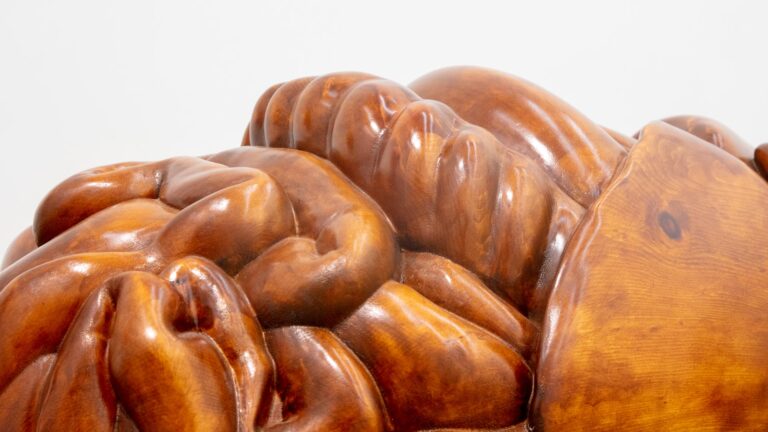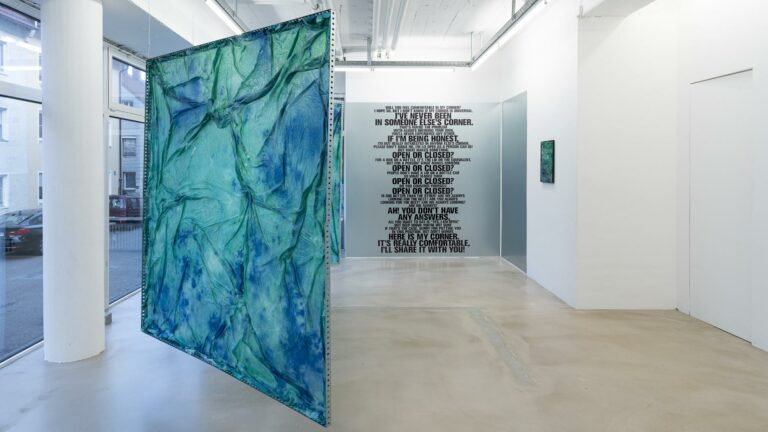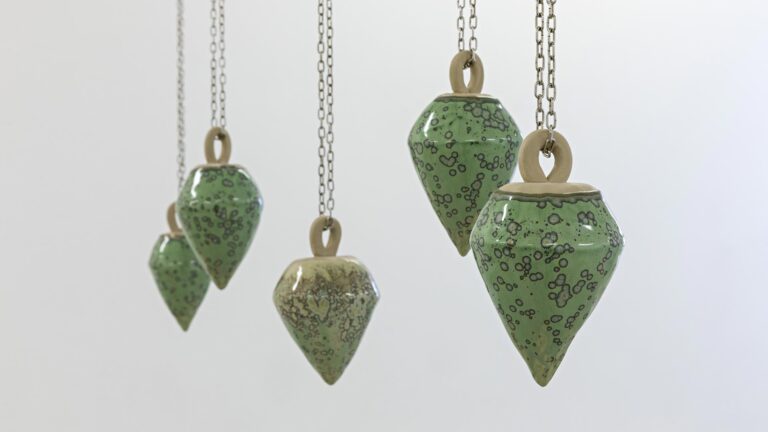Artist: Cécile Lempert
Exhibition title: An evening far
Venue: Super Super Markt, Berlin, Germany
Date: June 20 – September 1, 2024
Photography: all images copyright and courtesy of the artists and Super Super Markt, Berlin
In An evening far, Cécile Lempert presents a new body of work, united in a single installation. A total of six paintings (five of which are on display) and one sculptural work, all tightly connected through a continuous narrative, are shown in her first exhibition at Super Super Markt. The six paintings employ the formal language of traditional portrait painting: We see, in total, three women and three men in different postures but roughly within the range of a half figure.
With two standing figures at the flanks, one in full profile, the other in rear view and with a profil perdu, and an old woman in frontal view at the center, the paintings evoke a scene reminiscent of the Last Supper. More particularly, however, Lempert references the composition of Lotte Laserstein’s famous painting Evening Over Potsdam (Abend über Potsdam) (1930): The personage in her installation is arranged quite similarly, not to mention the distinct atmosphere that brings together a feeling of both unity and isolation, conversation and silence, peace and endangerment, a woeful gaze back and a worried look forth. The title of the exhibition makes this reference explicit, also alluding to the Last Supper, although its elliptic character leaves us with more questions than it gives answers: An evening far from what? And one might even think of Bob Dylan’s line “I’m one too many mornings and a thousand miles behind”.
Where the people in Laserstein’s painting are isolated through their reluctant body language, turning away from each other and seemingly all individually lost in their own thoughts, Lempert emphasizes this by scattering her models within the room, giving each a canvas for their own. The only exception is the painting An evening far II (2024) that shows a sitting man en face, with a woman standing behind him, apparently caressing his hair. This representation adds an intimate, tender aspect to the otherwise severe, and even dim scene, as does the soft orange light of a setting sun (with the latter nowhere to be seen). His gaze, however, is disturbing, directly fixating upon the observer, disrupting the silence of the other looks that all seem to be lowered or even turned inside.
As in Laserstein’s painting, a woman occupies the centerpiece of the supper scene in An evening far, but here she is elderly, perhaps eighty or ninety years old. One might even think that the woman from Evening Over Potsdam has grown old and is now surrounded, not by her friends from back then, but from a new generation. The common background of the paintings is as ambivalent as the assemblage in the foreground: To the right, it is rather minimalist, showing nothing but old-fashioned orange-brown kitchen-tiles, looking both dull and cozy. To the left, we have brutalist architecture in the background instead of the rather idyllic cityscape in Laserstein’s painting – and again, the result changes between the rather depressing effect of greyish concrete and surprising beauty of its warm hue and peaceful geometry. This change of scenery also recontextualizes the work temporally, although it does not play itself into the foreground and leaves these markers of the present rather vague.
Presented on a table in the back of the room, surrounded by the paintings, we see a sculpture of a medium sized dog, made of papier-mâché, rendered in a rather realist, yet playful style. This motif, too, is taken from the Laserstein painting. But while Laserstein places the dog peacefully under the table, Lempert displays her as if in a showcase or even on a dissecting table. Together with the asymmetrical panelling of the room with the equal-sized canvases, this installative element reveals the second crucial reference of the exhibition: Lempert takes up formal ideas from Joseph Beuys’ final grand installation, Palazzo Regale (1985), created shortly before his death: Where Beuys places brass panels in a large-scale upright format, reminiscent of blind mirrors, Lempert places her paintings, most of them translucid and elusive in different degrees, and where Beuys presents relicts from his famous installations and performances in two showcases (a lynx coat, an iron casting of a head, dried pieces of ham), Lempert presents this sculpture of a dog with its impoverished material. The effect on the spatial perception is similar, and even something of the atmosphere of Beuys’s room – dense, oddly sublime, reminiscent of, say, a chamber tomb – is conveyed in An evening far.
Both Beuys’ and Laserstein’s work are firmly rooted in their historical contexts, both of them capture a certain feeling, a social and political atmosphere, while expressing a turn to the inside. Both have the character of an inventory (look at Palazzo Regale and try not to think of Günter Eich’s famous poem Inventur), or even a testament. In this light, Lempert’s installation An evening far can be read similarly as an attempt to draw a balance and capture something crucial of the current Zeitgeist, much like Laserstein captures the atmosphere of the final years of the Weimar Republic: a sense of loss and the end of an era, a feeling of isolation and the longing for intimacy, and the foreshadowing of an existential danger ahead – quite naturally associations to the renewed rise of fascism and the ever harder striking climate crisis come to mind. But, again, like Laserstein, she does not engage with these topics directly, but through an intense look at, and psychological investigation of, her social environment, her family, and her friends.
– Jasper Lohmar























